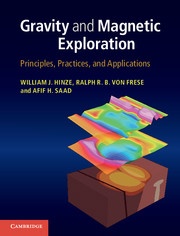Book contents
- Frontmatter
- Dedication
- Contents
- Preface
- Acknowledgements
- 1 Introduction
- Part I Gravity exploration
- Part II Magnetic exploration
- 8 The magnetic method
- 9 Magnetic potential theory
- 10 Magnetization of Earth materials
- 11 Magnetic data acquisition
- 12 Magnetic data processing
- 13 Magnetic anomaly interpretation
- Part III Applications
- Appendix A Data systems processing
- References
- Index
13 - Magnetic anomaly interpretation
from Part II - Magnetic exploration
Published online by Cambridge University Press: 05 May 2013
- Frontmatter
- Dedication
- Contents
- Preface
- Acknowledgements
- 1 Introduction
- Part I Gravity exploration
- Part II Magnetic exploration
- 8 The magnetic method
- 9 Magnetic potential theory
- 10 Magnetization of Earth materials
- 11 Magnetic data acquisition
- 12 Magnetic data processing
- 13 Magnetic anomaly interpretation
- Part III Applications
- Appendix A Data systems processing
- References
- Index
Summary
Overview
Magnetic interpretation, as in gravity interpretation, operates at several levels of complexity. It can range from simple identification and location of anomalous magnetic bodies in the subsurface to three-dimensional modeling leading to complete characterization of anomaly sources. However, there are numerous differences in the interpretation of these two potential fields. For example, magnetic anomalies in most investigations are primarily caused by contrasting crystalline rocks containing variable amounts of the trace mineral magnetite. This limits the range of possible anomaly sources that need to be considered, although as in all potential field interpretations no interpretation is unique.
Magnetic interpretation is complicated by the dipolar nature of the magnetic field, resulting in both attractive and repulsive effects from an anomaly source, and by the large range of variables that enter into determining the character of a magnetic anomaly. Anomaly characteristics vary significantly with the location and orientation of the source in the geomagnetic field and may be further complicated by the effects of remanent magnetization and internal demagnetization. Nonetheless, various interpretational techniques have been developed for dealing with these complications and shown to be successful in identifying and characterizing magnetic sources. Magnetic anomalies are particularly sensitive to their depth of origin, so special emphasis is placed on depth determination methods. Although these methods generally involve simplifying assumptions of theoretical formulations, with care errors commonly can be limited to roughly 10%.
- Type
- Chapter
- Information
- Gravity and Magnetic ExplorationPrinciples, Practices, and Applications, pp. 338 - 412Publisher: Cambridge University PressPrint publication year: 2013
- 1
- Cited by



